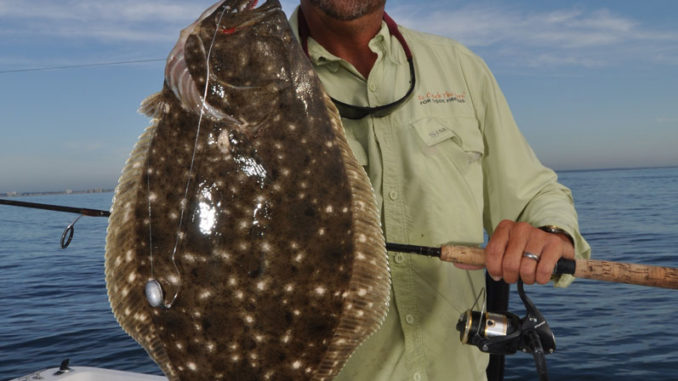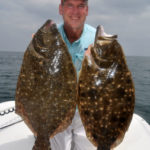
Get away from the crowd for the best flounder fishing artificial reefs have to offer.
Capt. Jamie Rushing headed offshore through Masonboro Inlet, his 21-foot boat gliding smoothly over glassy seas with his livewells full of menhaden and mullet in anticipation of a banner day.
“There lots of flounder out there,” said Rushing, who operates Seagate Charters. “We have caught some nice fish over the past week.”
Webster’s Dictionary says the word “rife” means abundant. While many local anglers know that ledges and wrecks hold flounder, they may not realize that the artificial reefs are literally rife with flounder.
“People don’t fish the artificial reefs as much as they fish the ledges,” he said. “The reason is, they become frustrated after their rigs break off in all of that structure. But if you’re not losing a few rigs, you’re not fishing in the right spots.”
Rushing soon spotted the buoy marking AR 370, the Meares Harris Reef, then slowed outboard to idle and checked his GPS and depthfinder.
“Look around at the anglers who are fishing the larger structure areas; that’s because they are the easiest to find,” he said. “But they are also the most difficult to fish; even your anchor will snag in all of that junk. Someone told me a long time ago that the best places to catch flounder are tiny marks well away from the barges, tugs and boxcars.
“There are scattered reef balls, concrete pipes and concrete pieces from bridges and other demolition projects. The little places also attract flounder, but far fewer predator fish like barracuda that might eat a flounder on the way to the boat and not as many bait stealers. Plus, the fishing is always more fun when you are not breaking off a rig every other cast.”
Once he found his spot, Rushing motored back and forth a few times to confirm its location and to work out an anchor course based on the wind direction. He said baitfish showing just off the bottom gave away the presence of a piece of concrete pipe.
“That’s all it takes to hold flounder,” he said. “If it’s hard to find, it hasn’t been fished to death.”
Rushing unshackled a fluked anchor, replacing it with a grapnel or “wreck” anchor. After dropping it on the edge of the structure, he pulled in the slack and tied the line around a bow cleat. Netting a mullet from a live well, he impaled it through the nose with a circle hook and dropped it to the bottom under the weight of an egg sinker. He was reeling in the slack when he felt a flounder strike.
“He’s already got it,” he said. “It feels like a nice one, too.”
The first fish of the day was a citation fish that weighed a touch more than five pounds. Rushing gave credit to the use of the 20-pound braided line on his reel.
“When you are fishing in water that can be 50 feet deep, you can feel the strike of a flounder better when you use a braid,” he said. “Mono stretches, so the strike feels mushy, or you might not detect it at all.”
Rushing uses circle hooks to hedge his bets, especially with clients aboard. Most anglers prefer using a Kahle or wide-bend hook.
“Most first-time flounder fishermen want to jerk the rod to set the hook as soon as they feel a strike,” he said. “I tell them to just let the bait stay there a minute or two, and the fish will hook itself — and that usually works. All you have to do is pick the rod up, and the circle hook catches the corner of the flounder’s mouth holds the fish until it’s in the net.”
Besides snagged rigs, the biggest problem with fishing around artificial reefs is the other fish the structure attracts, fish that can eat a baitfish before it can fall all the way to the bottom, which is the strike zone for flounder.
“You have to feed all of the other fish until the right one comes along,” he said. “A hundred baits won’t last very long on some days. That’s why I fill two live wells with baits and carry along some jigs.”
Once the baitfish supply has thinned out, Rushing ties on a jig using a 50-pound monofilament leader. He drops it down until it bumps the bottom, then reels it up a turn or two.
“Jigs are more expensive than rigs, and they won’t catch anything if they are stuck in the structure,” he said. “Once I establish the depth, I swim the jig above the bottom, bouncing it up a foot or two and letting it fall. A flounder will come up at least four feet to strike it.
“To keep it off the bottom, I strip line from the reel and count the strips as the jig falls. The same method works when fishing with live-bait rigs, but most people like feeling that bottom contact and the result is lost rigs and jigs.”
Most days, Rushing and his clients catch at least 10 to 12 keeper flounder, and many times, they catch their limits, with one or two citation fish showing up each time out.
“The flounder we catch offshore are usually larger on the average than the fish we catch at the inlet or the inside waters,” he said. “The action is faster, and you may only have to move and re-anchor the boat a time or two, if at all. It’s not like inside fishing where you are always hopping around, hoping to catch one or two fish from each spot you try.”
While Rushing fishes the reefs closer to Masonboro Inlet, including AR 370 and 364, the Billy Murrell Reef, Capt. Dennis Barbour of Carolina Beach’s Island Bait and Tackle fishes AR 378, the Philip Wolfe Reef, because it is closer to Carolina Beach Inlet.
“I keep my boat in the Carolina Beach basin and catch mullet right beside the boat before I head out for a day of fishing,” Barbour said. “I’ve been fishing 39 years, and the reefs have always held flounder. Most anglers fish the wrecks, but forget about how good the fishing can be at AR 378 because they don’t like fishing shoulder-to-shoulder with the other boats.”
When Barbour arrived at the reef, he had predicted the fishing pressure well. Many boats were at anchor in various locations, and most of the anglers could carry on conversations with their neighbors without having to use a VHF radio.
“Look around and you will see the same boats fishing on the same spots day after day,” he said. “Everyone has a favorite piece of structure where the have caught flounder. They figure out a place or two where they do not get their rigs snagged every time and keep returning to fishing that same spot.”
After nodding and smiling to several other anglers, Barbour eased over one of his favorite locations. He used his GPS and depthfinder to locate a concrete patch.
“I don’t know if it is pipe or rubble,” he said. “But it’s definitely concrete and not a ship.”
Unlike the spot Rushing prefers fishing, this one was littered with concrete. Barbour had come prepared for snagged hooks.
“I use gold Kahle hooks because they usually bend enough to pull them free,” he said. “If the leader breaks, I just tie on another one. I keep dozens of leaders inside pieces of pipe insulation.”
Barbour has a different tactic for preventing snagged hooks and lines. He tells his clients not to reel in or lift the rod until a fish is on the line.
“When the flounder are here, they are inside all of that structure,” he said. “If you drop the bait straight down and reel the fish straight back up, you won’t get your hook snagged. But if you keep checking your bait and casting and reeling in your line, it will get snagged nearly every time.”
Barbour started catching flounder as fast as he could net them, replace the bait and drop it down. As the bite tapered off, he cast outward and reeled the bait in very slowly.
“Once you have caught the fish right beneath the boat, you can cast away from the structure and reel the bait back in along the bottom. That way, you can find the flounder that are along the outer edges of the structure. If I feel the structure, I stop and let the bait sit until a fish eats it.”
Although Barbour has used using jigs to catch flounder, he said the structure he fishes is too dense.
“My clients would keep snagging jigs in the structure because some of it is so high,” he said. “But for anglers who know how to use them properly, they are a great alternative to using live baits.”
DESTINATION INFORMATION
HOW TO GET THERE/WHEN TO GO — A popular public boat ramp is just off US 74, on the Wrightsville Beach side of the drawbridge across the ICW. I-40 and US 421 will get most North Carolina fishermen to Wilmington, and US 74 will get them to the beaches. Nearshore reefs most accessible are AR 364 (34 14.833/77 42.833), AR 370 (34 10.467/77 45.067), AR 378 (34 00.633/77 50.683). All three are between six and nine miles from Masonboro Inlet. Small flounder typically arrive on the reefs in April, with bigger fish showing up in May. The bite will continue into September.
TACKLE/TECHNIQUES — Most fishing with live bait (menhaden, mullet) is done with a Carolina rig featuring a 1½-ounce egg sinker and 4/0 Gamakatsu circle hook tied with 50-pound mono leader or a 1/0 gold Eagle Claw Kahle hook and 30-pound mono leader knotted to the hook and swivel. White Sea Striker or Spro bucktails in ¾- and 1-ounce sizes tipped with a pink or purpose Gulp! Punk Prawn trailer will work when live bait isn’t available. Spinning rods rated for 6- to 12-pound in 6-foot-6 and 7-foot lengths and 3000 series reels spooled with 20-pound braid are common outfits for reef flounder.
FISHING INFO/GUIDES — Jamie Rushing, Seagate Charters, 910- 232-9693; Dennis Barbour, Island Tackle and Hardware, Carolina Beach, 910-458-3049 or 910-470-5041. See also Guides and Charters in Classifieds.
ACCOMMODATIONS — Sleep Inn, Wilmington, 910-313-6665, Pleasure Island Chamber of Commerce, www.pleasureislandchambernc.org.
MAPS — Capt. Segull’s Nautical Charts, 888-473-4855, www.captainsegullcharts.com ; Maps Unique, 910-458-9923, www.mapsunique.com.







Be the first to comment